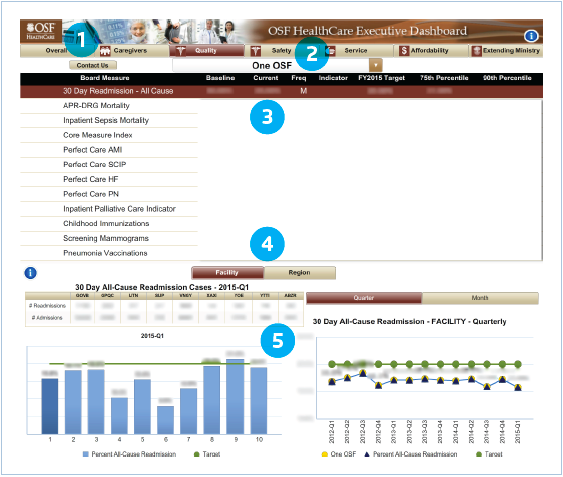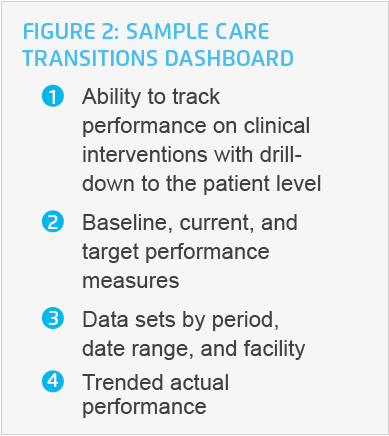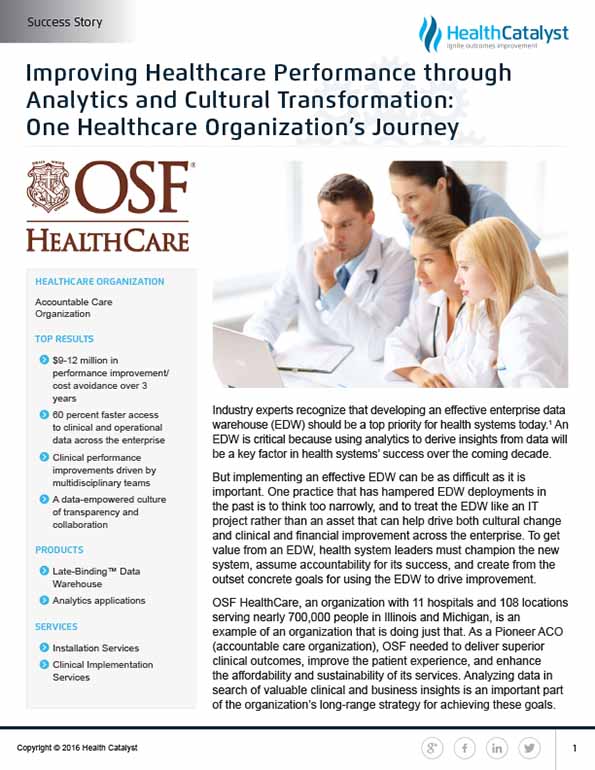OSF HealthCare aimed to enhance clinical outcomes and patient experience while improving affordability. The organization revamped its performance measurement system by adopting new analytics and fostering a data-driven culture. This approach saved $9-12 million over three years and improved clinical performance in areas like heart failure and palliative care.
Industry experts recognize that developing an effective enterprise data warehouse (EDW) should be a top priority for health systems today.1 An EDW is critical because using analytics to derive insights from data will be a key factor in health systems’ success over the coming decade.
But implementing an effective EDW can be as difficult as it is important. One practice that has hampered EDW deployments in the past is to think too narrowly, and to treat the EDW like an IT project rather than an asset that can help drive both cultural change and clinical and financial improvement across the enterprise. To get value from an EDW, health system leaders must champion the new system, assume accountability for its success, and create from the outset concrete goals for using the EDW to drive improvement.
OSF HealthCare, an organization with 11 hospitals and 108 locations serving nearly 700,000 people in Illinois and Michigan, is an example of an organization that is doing just that. As a Pioneer ACO (accountable care organization), OSF needed to deliver superior clinical outcomes, improve the patient experience, and enhance the affordability and sustainability of its services. Analyzing data in search of valuable clinical and business insights is an important part of the organization’s long-range strategy for achieving these goals.
For several years OSF’s leaders had prioritized analytics as a key component of their strategic plan, but they had yet to find an effective system for using data to consistently deliver greater value to patients and stakeholders. The ACO was, in fact, experiencing data overload, combined with a lack of actionable information. Its existing measurement and reporting system didn’t adequately help leaders determine whether they were measuring the right things, whether they could improve performance with adequate speed and effectiveness, or whether they were successfully creating a culture of transparency and clinical excellence.
OSF’s leaders recognized that to effectively achieve their goals, they needed to reinvent the organization’s performance improvement measurement and reporting system for both operations and clinical care. Such reinvention would require a highly integrated and functional EDW that could support interactive access to useful information.
The organization already had two unsuccessful attempts at implementing an EDW under its belt—failures largely attributed to treating the development of the EDW as a siloed IT project. This history meant that leaders would have to overcome skepticism in the organization about the effectiveness of EDWs. In order for this new effort to be seen as a success, leaders knew they would need to:
Rather than just deploy new analytics technology, OSF needed to drive a cultural shift throughout the organization to embrace becoming a data-empowered system.
OSF’s successful solution to these challenges began with the implementation of a late-binding EDW from Health Catalyst. This EDW aggregates clinical, claims, financial, and other data to create a consistent view of the ACO’s data—a single source of truth to inform decisions. The EDW served as an important foundation of useful, timely, and accessible information for stakeholders throughout the organization to guide improvement efforts.
However, as OSF leaders had learned through experience, technology accounts for just 30 percent of a successful EDW implementation; the remaining 70 percent consists of solid execution and aligning the analytics strategy with the organization’s business goals. A successful implementation would require both clinical and business buy-in. Determined not to repeat past mistakes, they guided their plan by what they had learned: To successfully implement an analytics strategy it is necessary to know (and `agree on) what you are going to do with the data to get the results you want. Consequently, they determined that the organization’s top priorities upon implementing the EDW were to:
To encourage the ongoing engagement of leadership and ensure organizational alignment with the overall strategic plan, the OSF team rolled out an Executive Dashboard, enabled by the EDW (see Figure 1). The Executive Dashboard provides transparency across the organization to leaders and staff around performance measurements and outcomes. It also serves as the source of truth for aligning performance—both clinical and operational—to meet the strategic goals of the organization. The dashboard brings value in the form of quick access to data that can identify opportunities for improvement. This, in turn, enables leaders to make data driven decisions to support their improvement teams to accomplish quick implementation of key interventions to improve performance.


Figure 1: Sample Executive Dashboard
The Executive Dashboard provides summary views and trends, as well as drill-down capabilities to filter into greater detail on individual metrics.
Dashboards are only truly effective when used to identify and implement specific interventions to improve performance—with each intervention contributing to the attainment of the overall strategic goals. To make sure that the high-level goals were integrated and aligned from the executive level to the frontline staff, the OSF team:
A prime example of this process in action was the development of the Care Transitions Dashboard (see Figure 2)—developed by a multidisciplinary team dedicated to improving quality of care. This team analyzed the data in the EDW and reviewed best practices to determine the right interventions for preventing 30-day heart failure (HF) readmissions. They were able to use the Care Transitions Dashboard to trend HF 30 day readmissions and the completion of prescribed interventions—such as risk assessments, discharge summaries, and medication reconciliation. Through this process, they were able to see how the specific interventions affected outcomes.


Figure 2. Sample Care Transitions Dashboard
Within a few months of launching the EDW initiative, OSF began to see value from the new analytics system. This unprecedented time to value was possible because they implemented the late-binding EDW in 90 days, and OSF had developed an organizational culture and structure that was prepared to use the EDW. The unique late binding architecture enabled the ACO to derive value from the system incrementally. Through careful planning and empowerment of strategically focused improvement teams, they were able to quickly leverage the new technology and tools in the areas where they could have the most impact, and then build on those successes. Today, the cumulative value OSF has realized through this effort is significant—and still growing.
By engaging leadership, aligning the EDW initiative with business strategies, and building data-driven clinical and operational improvement teams, OSF was able to save $9-12 million over three years. The organization generated the savings through both process improvement and cost avoidance.
OSF delivered quick, self-service access to data by creating strategic dashboards that run on the EDW. This level of systemwide data access was key to proving the value of the EDW and gaining support for subsequent data-driven projects. Automated data access also drove an 80 percent reduction in customized report requests. This enabled OSF to refocus the efforts of 2.7 FTEs from data gathering to analysis and improvement—an additional benefit of creating a strong analytic system and a culture that values data. (See Figure 3)

By creating multidisciplinary performance-improvement teams and empowering them with integrated data and analytics, OSF was able to use actionable information to improve patient care. The following are examples of outcomes achieved by improvement teams:
Heart Failure Program
The multidisciplinary heart failure team partnered with OSF’s analytics team to pull baseline data from the EDW and develop a heart failure dashboard. Using the dashboard, the team tracked key process and outcome metrics to inform caregivers of where their processes diverged from best practices. OSF heart failure care subsequently improved across three tracked processes:
Cardiovascular Physician Dashboard
The multidisciplinary cardiovascular team embarked on an initiative to improve quality by identifying a series of best-practice measures for cardiologists. The team partnered with the OSF analytics team to develop a dashboard that would track these measures and compare physicians’ performance against their peers. The two teams worked together throughout the build process to define components and validate data. In just seven months’ time, the initiative has resulted in improvements in each tracked measure—and through ongoing focus they anticipate continued improvement.
Palliative Care Program (view case study)
OSF needed an effective method for documenting both advance care planning discussions and the advance care plans themselves. The organization used the EDW and the Instant Data Entry Application (IDEA) from Health Catalyst for data aggregation, risk stratification, documentation, and reporting across its heterogeneous EHR environment to identify high-risk patients. OSF has completed, documented, and aggregated advance care planning for more than 16,000 patients.
With the EDW and new team structures in place, OSF has created a data-empowered culture that will drive all future improvement efforts. This culture enlists the support of leadership as well as identifying owners of each initiative at the outset to ensure accountability and shared goals. In parallel, OSF has more tightly aligned its priorities, quality measures, and action plans with specific improvement goals. The organization ties data to specific interventions, which allows stakeholders throughout the organization to see the value and clinical impact of quality improvement. As individual teams implement best practices and drive progress, they share those practices throughout the organization to drive performance.
OSF will continue to develop its data-powered culture of transparency fueled by integrated analytics. It has, in fact, developed a system-wide improvement portfolio that it will tackle incrementally based on quality and cost priorities. Current priorities include population health management, patient safety, and improved care delivery in strategic service lines such as cardiovascular, neurosciences, pediatrics, and oncology.
The organization will also continue to expand its technology capabilities around analytics, including enhancing its ability to monitor and quantify its progress in improving care and operational efficiency. In the near term, OSF seeks to improve clinical decision support by tying EDW information into its EHRs to enable immediate use of data by frontline staff to deliver appropriate care. They plan to expand the effectiveness of their analytics platform by deploying additional applications to support their key strategic priorities. OSF also wants to support their research efforts with academic partners, improve their population and drive business decisions, which will be enabled by expanding their capacity to provide aggregated and de-identified data.




